Sharks – creatures of immense power and mystery that are found in the vast, enigmatic depths of our world’s oceans.
These apex predators, with their streamlined bodies and fearsome jaws, have swum through the annals of our history, leaving behind tales that oscillate between awe and terror.
From the sun-drenched Jersey shore to the secluded, pristine waters surrounding Guadalupe Island, sharks have etched indelible marks on human narratives, sometimes as the fearsome predator and, in more recent times, as the misunderstood giant of the deep.
This article includes these five memorable historic great white shark encounters:
- Jersey Shore: A series of attacks that resulted in four fatalities and one injury over 12 days, which is said to have inspired Peter Benchley’s novel “Jaws” and its subsequent film adaptation by Steven Spielberg.
- USS Indianapolis: After the ship sank during WWII, survivors in the Pacific Ocean faced numerous challenges, including shark attacks, while awaiting rescue.
- Rodney Fox: Fox survived a Great White Shark attack while spearfishing off the coast of South Australia and later became an advocate for shark conservation.
- Deep Blue: The massive Great White Shark, first identified in the 1990s, gained widespread recognition after a notable encounter with researchers near Guadalupe Island, showcasing her immense size and contributing to ongoing research and conservation efforts.
- Thomas Butterfield: Butterfield was fatally attacked by a giant Great White Shark while bodyboarding in Morro Bay, California.
Embark on a journey through time and tide as we delve into five poignant encounters between humans and great white sharks, exploring stories of survival, tragedy, and unexpected kinship.
1) The Jersey Shore Incidents, 1916
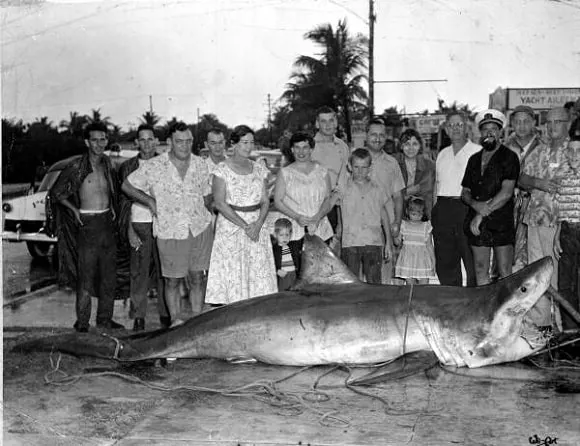
The Jersey Shore shark attacks of 1916 were a series of tragic incidents that unfolded between July 1 and 12, resulting in four fatalities and one critical injury.
These attacks have been deeply embedded in American history and pop culture, inspiring documentaries and episodes on various channels like the History Channel and National Geographic Channel.
The attacks are said to have changed America’s perception of sharks and instilled a widespread fear of them.
Let’s take a closer look at the five shark encounters that make up the Jersey Shore incident.
Encounter 1: Charles Epting Vansant
On July 1, 1916, Charles Epting Vansant, a 28-year-old from Philadelphia, decided to take a quick swim in the Atlantic at Beach Haven before dinner.
Not long after entering the water, Vansant began shouting as a shark started to attack him.
Lifeguard Alexander Ott and bystander Sheridan Taylor managed to rescue him, but Vansant bled to death after the shark bit his legs, stripping the flesh from his left thigh.
Encounter 2: Charles Bruder
The second major attack occurred on July 6, 1916, at Spring Lake, New Jersey.
Charles Bruder, a 27-year-old Swiss bell captain, was attacked while swimming 130 yards from the shore.
The shark bit him in the abdomen and severed his legs. Bruder bled to death before being brought back to the shore, causing panic and fainting among the onlookers.
Encounter 3, 4, and 5: The Matawan Creek Attacks
The subsequent three attacks occurred in Matawan Creek near Keyport on July 12.
Lester Stilwell, an 11-year-old boy, was playing with friends when a shark pulled him underwater. Despite the boys running to town for help and several men, including 24-year-old Watson Stanley Fisher, diving into the creek to find Stilwell, the boy did not survive.
Fisher was also attacked by the shark and died later from the injuries.
These attacks led to a wave of panic that resulted in shark hunts aimed at eradicating “man-eating” sharks and protecting the economies of New Jersey’s seaside communities.
The incidents also forced ichthyologists to reassess common beliefs about sharks and the nature of shark attacks.
The debates about which shark species was responsible and the number of animals involved continue, with the great white shark and the bull shark being most frequently cited.
PRO TIP: For a more detailed account, you might find this article from HISTORY and this one from American Oceans informative.
2) The USS Indianapolis, 1945
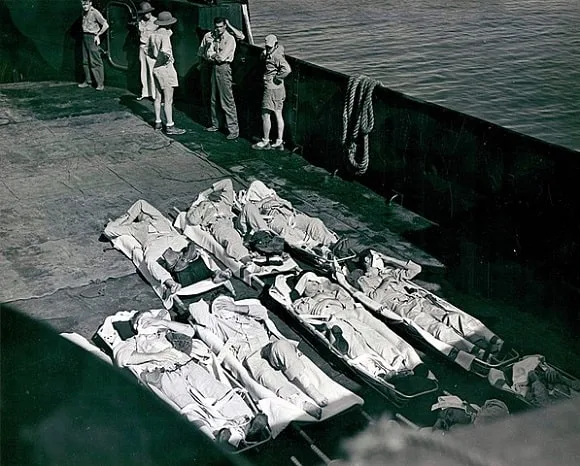
The USS Indianapolis, a heavy cruiser, played a pivotal yet tragic role during World War II, becoming synonymous with one of the most harrowing sea tales involving shark attacks.
Here are some key points and additional information about the incident:
The Sinking of the USS Indianapolis
In July 1945, the USS Indianapolis met a tragic fate when two Japanese torpedoes sank it after delivering parts for one of the two atomic bombs that would eventually lead to Japan’s surrender in September of the same year.
888 Americans were killed in this incident, and the ship’s sinking was dramatized in the 1975 movie “Jaws.”
The Horrifying Aftermath
The sinking of the Indianapolis led to approximately 900 men being stranded in the Pacific Ocean, where they faced exposure, dehydration, saltwater poisoning, and numerous shark attacks while floating with the few lifeboats and lifevests available.
For four to five days, the survivors endured the terrifying shark attacks, which are described as the deadliest in history.
Quint’s Monologue in “Jaws”
One of the most chilling scenes in the film “Jaws” is Quint’s recounting of his time serving on the USS Indianapolis and witnessing his friends being attacked by sharks when the ship sank.
This monologue was not only a pivotal moment in the film but also brought the horrifying event from WWII into popular culture.
Interestingly, Robert Shaw, who played Quint, contributed to writing the iconic USS Indianapolis speech, which was initially “insanely long” and went through various writers before Shaw’s four-minute version made the final cut.
Legacy and Remembrance
Even decades later, the USS Indianapolis and its crew are remembered and honored.
Efforts like Project 888 aim to locate descendants of all 888 servicemen who died during the incident, ensuring their sacrifices are “always remembered and never forgotten.”
The Indianapolis story is not only a tale of tragedy and loss but also a reminder of the bravery and endurance of its crew.
3) Rodney Fox, 1963
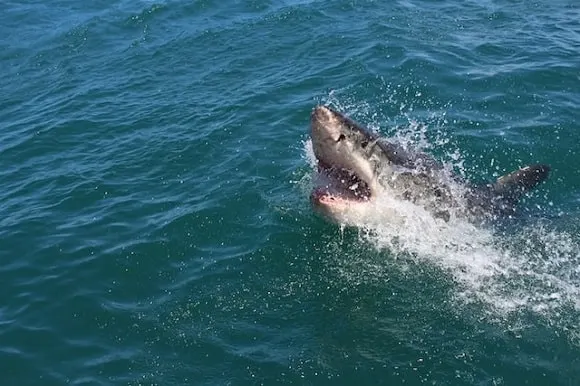
Rodney Fox’s encounter with a great white shark in 1963 off the coast of Australia is not only one of the most infamous shark attacks in history but also a story of survival, transformation, and conservation.
The Fateful Encounter
Rodney, an avid spearfisher, experienced a life-altering event at the age of 23.
While defending his title in a spearfishing competition about 30 miles south of Adelaide, he was brutally attacked by a great white.
The attack was so severe that his wetsuit was the only thing preventing his organs from spilling out.
Rodney sustained a punctured diaphragm, a torn lung, and a pierced shoulder blade. Furthermore, his abdomen, ribcage, spleen, and stomach were exposed as the shark dragged him underwater.
Miraculously, he survived the attack, requiring 462 stitches.
The Aftermath and Transformation
Despite the trauma and the physical injuries sustained from the attack, Rodney did not distance himself from the ocean or the creatures that nearly took his life.
After his recovery, he initially sought to hunt sharks along the Australian coast.
However, his journey took a different turn when he began working on documentaries about sharks, which led him to realize the importance of these apex predators in maintaining the balance of the ocean’s ecosystems.
Advocate for Sharks
Interestingly, Fox transformed from a shark attack victim to one of the most vocal advocates for shark conservation.
He emphasized the ecological role of sharks, highlighting that they regulate marine ecosystems by preying on the weak, sick, and slow, thereby controlling the populations of other animals and maintaining the health of the oceanic environment.
Rodney Fox Shark Expeditions
Rodney’s passion for sharks and the ocean led him to establish Rodney Fox Shark Expeditions, now managed by his son Andrew.
The organization focuses on providing people with life-changing underwater experiences with sharks and educating them about the importance of these magnificent creatures.
Rodney believes that sharks, despite being fierce predators, play a crucial role in the environment and should be protected and preserved.
A Tale of Resilience and Coexistence
Rodney Fox’s inspiring story is about survival and understanding, coexisting, and advocating for creatures that once posed a personal threat to him.
His experiences and subsequent conservation efforts underscore the importance of respecting and protecting the natural world, even when faced with personal adversity.
4) Encounter with Deep Blue, 2013
Number 4 is an example of a very positive great white shark encounter!
Deep Blue, an enormous female great white shark, has captured the world’s attention due to her impressive size and remarkable encounters with her.
Estimated to be over 50 years old, she spans a staggering 20 feet in length and weighs around 5,500 pounds.
Although first discovered in the 1990s, Deep Blue gained widespread recognition after a 2013 encounter with shark expert and researcher Mauricio Hoyos Padilla near Guadalupe Island.
The footage of this encounter, which showcased her immense size and majesty, was first aired in 2014 as part of a Shark Week documentary.
Deep Blue’s fame skyrocketed in 2015 when a video of her posted by Hoyos Padilla went viral on Facebook, earning her the title of the biggest great white shark in the world.
Despite her massive size and potential threat, encounters with Deep Blue have provided invaluable insights into the behaviors and mysteries of great white sharks, contributing to ongoing research and conservation efforts.
A Majestic Giant of the Ocean
Deep Blue’s sheer size and age highlight the incredible growth potential and longevity of great white sharks, offering researchers unique opportunities to study and understand the life cycle and behaviors of these apex predators.
A Symbol of Mystery and Research
Deep Blue’s interactions with researchers and her appearances in various documentaries have not only demystified some aspects of great white shark behavior but also underscored the numerous secrets these creatures still hold, propelling further research and exploration.
The Intersection of Fear and Fascination
The viral fascination with Deep Blue reflects the collective awe and fear that great white sharks instill in the public imagination.
Her existence and encounters with humans serve as a reminder of the mysteries, dangers, and wonders that lie beneath the ocean’s surface and stress the importance of marine conservation efforts and environmental sustainability.
5) Thomas Butterfield, 2021
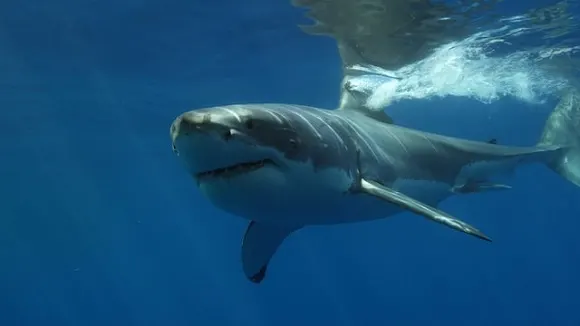
Tomas Butterfield, a 42-year-old bodyboarder, faced a tragic end when a great white shark attacked him on Christmas Eve of 2021 near Morro Rock, California.
The shark bit him so fiercely that it penetrated his skull and left a tooth embedded in his back.
Butterfield, who was visiting his mother in Morro Bay for Christmas, went to the beach around 10 am.. His body was found at 10:39 am.
A Brutal Attack
The sheer force of the shark’s bite, capable of penetrating Tomas Butterfield’s skull, underscores the formidable strength and power of great white sharks.
This incident brings to light the potential dangers that ocean-goers may face, even in activities as seemingly benign as bodyboarding.
A Timely Rescue
Despite the horrifying incident, a woman managed to pull his body from the sea, preventing it from being lost to the ocean.
The rescue was crucial in ensuring that the family had closure and could recover his remains.
Butterfield’s family expressed gratitude towards her, stating that she is now considered part of their family.
The Unpredictability of Nature
Tomas Butterfield’s tragic encounter is a sad reminder of the unpredictability of nature and the risks associated with ocean activities.
It emphasizes the importance of being vigilant and prepared when engaging in water sports, especially in areas known for shark sightings.
In Defense of the Ocean’s Formidable Giants
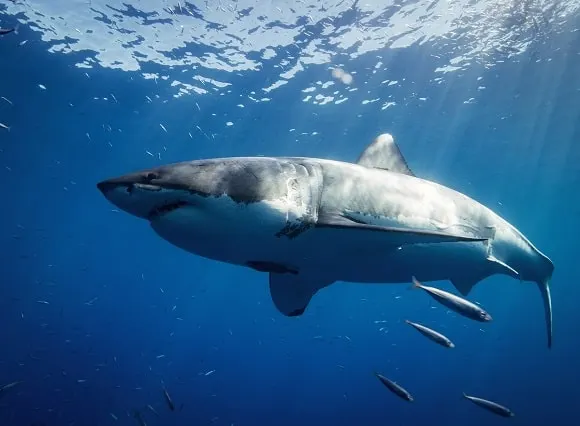
In the shadowy depths of our oceanic realms, great white sharks glide silently, their mere presence often evoking fear and awe in equal measure.
Their encounters with humans, some of which have been tragically fatal, have painted them with a brush of malevolence in popular culture, casting them as the villains of the deep.
Beneath the surface of these narratives lies a truth often overshadowed by fear.
Great white sharks, with their impressive size and formidable hunting skills, are apex predators, meaning they sit at the very top of their food chain.
Their predatory behaviors are vital in maintaining ecological balance, regulating prey populations, and ensuring the health and diversity of their ecosystems.
By preying on the weak and sick, they help to control the spread of diseases among fish populations and prevent any single species from overpopulating and overgrazing seagrass beds and other vital habitats.
Despite their fearsome reputation, great white sharks are far more endangered by human activity than we are by them.
Overfishing, habitat destruction, and climate change pose significant threats to their populations, disrupting their habitats and food sources.
The decline of these magnificent creatures could have cascading effects on our ocean ecosystems, potentially destabilizing the balance supporting a myriad of marine life in our oceans.
In light of their importance and the threats they face, shifting our perspective from fear to respect and understanding becomes imperative.
Conservation efforts, research, and initiatives promoting sustainable coexistence are crucial in safeguarding the future of the great white shark.
By protecting them, we are preserving the rich tapestry of life that thrives beneath the waves and ensuring the health and vitality of our oceans for generations to come.
In the tales of encounters and close calls, let us find not just stories of fear and tragedy but also reminders of our intrinsic connection to and dependence on the natural world.
May the narratives of the past inspire a future where humans and sharks coexist harmoniously, respecting and protecting the delicate balance that sustains life both above and below the ocean’s surface!
Additional Reading About the Importance of Great White Sharks
These sources provide a wealth of information about the crucial role that great white sharks, and sharks in general, play in maintaining the health and stability of marine ecosystems.
They underscore the importance of conservation efforts and the need to protect these magnificent creatures to preserve the balance and biodiversity of our oceans.
Highlights the role of sharks as apex predators in maintaining species below them in the food chain and serving as indicators for ocean health.
Discusses the ecological role of white sharks as apex predators and their status as an iconic species in the oceans.
Explores the ecological importance of sharks, emphasizing their role as apex predators and their impact on biodiversity and population regulation in their ecosystems.
Explains the role of sharks in promoting biodiversity and maintaining healthy ecosystems.
Concludes the significant position of great white sharks in marine ecosystems, focusing on their role in regulating populations and maintaining ecological balance.
Related Articles
- What Is the Maximum Size of Great White Sharks?
- 40 Awe-Inspiring Great White Shark Facts
- What Is the Biggest Hammerhead Ever Recorded?
Featured image by Elias Levy – CC BY 2.0

